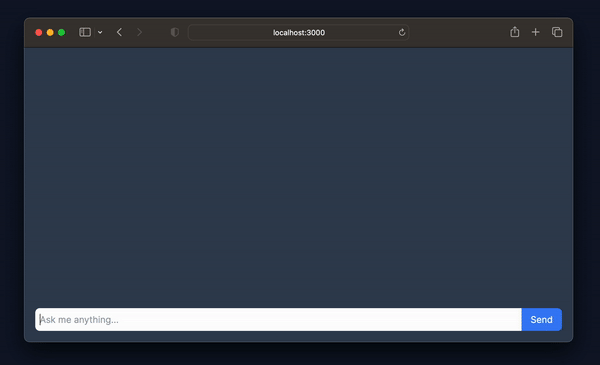https://github.com/xd2sketch/react-chat-stream
⚛️ React Hook to add 🤖 ChatGPT-like word-by-word event streams
https://github.com/xd2sketch/react-chat-stream
chatgpt event event-stream nextjs react
Last synced: 9 months ago
JSON representation
⚛️ React Hook to add 🤖 ChatGPT-like word-by-word event streams
- Host: GitHub
- URL: https://github.com/xd2sketch/react-chat-stream
- Owner: XD2Sketch
- License: mit
- Created: 2023-07-12T07:23:28.000Z (over 2 years ago)
- Default Branch: main
- Last Pushed: 2024-12-01T20:50:07.000Z (about 1 year ago)
- Last Synced: 2025-03-27T22:05:26.153Z (9 months ago)
- Topics: chatgpt, event, event-stream, nextjs, react
- Language: TypeScript
- Homepage: https://www.npmjs.com/package/@magicul/react-chat-stream
- Size: 391 KB
- Stars: 64
- Watchers: 2
- Forks: 12
- Open Issues: 10
-
Metadata Files:
- Readme: README.md
- Changelog: CHANGELOG.md
- License: LICENSE
Awesome Lists containing this project
README
# @magicul/react-chat-stream





Introducing @magicul/react-chat-stream: A React hook designed to simplify integrating
chat streams returned by your backend. Let messages appear word-by-word similar to ChatGPT.
## What's this package about?
Are you building a ChatGPT-like chat interface? Then most likely you'll want to integrate a chat that has the messages appear word-by-word, similar to ChatGPT. Vercel recently released the [Vercel AI SDK](https://vercel.com/blog/introducing-the-vercel-ai-sdk#streaming-first-ui-helpers) which adds _Streaming First UI Helper_, but what if you want to integrate your own backend? This package solves exactly that pain point. We've abstracted the logic into a React Hook to take care of handling everything for you.
## How does it work?

If you're backend returns `text/event-stream` then you can use this package. This package does not "fake" this response by imitating the word-by-word appearance. It will literally take the responses from your backend as them come in through the stream. The hook provides a `messages` object which will change so you can display it as the result gets delivered.
## Installation
Install this package with `npm`
```bash
npm i @magicul/react-chat-stream
```
Or with `yarn`
```bash
yarn add @magicul/react-chat-stream
```
## Stream chat-like messages from your backend to your React app (similar to ChatGPT).
With the `useChatStream` hook, you can easily integrate your own API
to stream chat responses (`text/event-stream`). Responses from your backend will appear
word-by-word to give it a ChatGPT-like user experience. The following
example demonstrates how to use the hook to integrate your own API
that streams the results.
_Please note_: Your API has to return `text/event-stream`.
```tsx
import React from 'react';
import useChatStream from '@magicul/react-chat-stream';
function App() {
const { messages, input, handleInputChange, handleSubmit } = useChatStream({
options: {
url: 'https://your-api-url',
method: 'POST',
},
// This means that the user input will be sent as the body of the request with the key 'prompt'.
method: {
type: 'body',
key: 'prompt',
},
});
return (
{messages.map((message, index) => (
{message.role}: {message.content}
))}
Send
);
}
export default App;
```
The `useChatStream` hook provides a variable named `messages`. This
`messages` variable comes from the internal state of the hook. It contains the chat message reply received from
your API. Messages are updated in real-time as the stream continues to receive messages. The `messages` variable will change and will get
appended with new messages received from your backend.
**Important: For this to work, your API must stream back the results
of the AI model as parts of the string you want to display.**
## Endpoint Requirements
The API endpoint you provide to the hook must be able to handle the
following:
- Accept a request with a JSON body or a request with a query string
for the prompt.
- Respond with a `event/text-stream` event stream which contains the
responses you would like to display.
## API Reference
### Input:
The input of the hook is a configuration object with the following
properties:
#### options
- url: `string` - the URL of the API endpoint.
- method: `'GET' | 'POST'` - the HTTP method to use.
- query: `object (optional)` - the query parameters to send with the
request.
- headers: `object (optional)` - the headers to include in the
request.
- body: `object (optional)` - the body of the request.
- fakeCharactersPerSecond: `number (optional)` - the number of
characters to display per second. If this is unused the hook will display the messages as they come in.
#### method
- type: `'body' | 'query'` - where to include the user's input in the
request.
- key: `string` - the key of the input in the request.
### Output:
The output of this hook is an object with the following properties:
- messages: `Array` - an array of chat messages. Each
message is an object with an `id` (can be used as a key in the
loop), `role` ('bot' or 'user') and `content` (
the content of the message).
- input: `string` - the current user input, you can use this value as
the form input value.
- handleInputChange: `function` - a function to handle the change
event of the input field. Pass it to the onChange prop of your input
field.
- handleSubmit: `function` - a function to handle the submit event of
the form. Pass it to the onSubmit prop of your form.
- isLoading: `boolean` - a boolean indicating whether the request is
in progress.
## Examples
If you want to see a working example, check out the [example](./example)
folder for an example on how to use this package.
## Important Notes:
For those utilizing Next.js version 13 or higher as the server-side
rendering framework with React, it's crucial to incorporate the
useChatStream hook within a client component. The need for this is
driven by the hook's use of useState, which necessitates its operation
within a client component.
Transforming a regular server component into a client component is a
straightforward task. Simply add the following line at the top of your
component file:
```tsx
'use client';
```